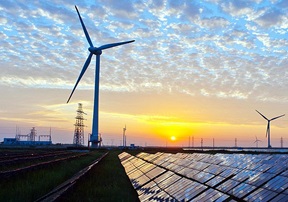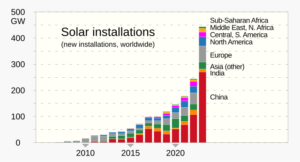In the Netherlands, the business case for wind turbines and solar panels keeps getting worse; writes Roy op het Veld on change.inc (in Dutch). The supply side of the energy system isn’t the bottleneck anymore – it’s the demand side. Without demand stimuli, solar and wind electricity will keep falling in price.

Energy transition
Op het Veld writes that from now on, the energy transition enters a new phase. In the present phase, demand needs to start moving. In part, this is the consequence of the success of supply stimulation. There are no streets anymore without a roof covered with solar panels. And for the North Sea, the same now holds: one wind park after another has been installed.
According to the latest figures of the national statistical bureau CBS, all solar panels together in the Netherlands had a capacity of 21.275 MW. More than double that of all wind turbines, which had a combined capacity of 10.734 MW. But wind turbines have a much higher operating time, causing national wind supply (23%) to be higher than national solar supply (17% of renewable electricity). Although more than half of electricity supply is from renewable sources now, according to CBS figures last September.
Limits to renewable electricity
Supply of renewable electricity now runs into limits, because of grid capacity and lack of storage. The value of this electricity consequently goes down. The financial yield of installing more wind turbines and solar panels therefore falls. Yes, there is a lot of revenue if the sun shines and there is a lot of wind. But in other situations we need backup, typically delivered by gas-powered stations. This problem will grow as more solar panels and wind turbines are being constructed.

There is just one single solution to this problem: stimulate the demand for sustainable electricity. Equipment now powered by natural gas, houses now heated by natural gas, need to shift to electricity – from renewable sources. But that is easier said than done. Electricity demand in the Netherlands hasn’t grown for about twenty years now. And 80% of residential homes are still heated by natural gas and a central-heating boiler.
Will we shift away from gas?
So finally, is there a plan at all to move away from gas? People have invested in better insulation. Consequently, their demand for heat falls, and that doesn’t bode well for district heating systems. Maybe there are entrepreneurs who come up with proposals, attractive in the new situation?
Industry, in fact, finds itself in the same situation as home owners. There is very little financial motive for a shift towards sustainable heat. There is almost no progress in agreements with major polluters. We need new policies in order to overcome this situation. The move towards sustainability needs to get a form backing. It is no use constructing new wind parks on the North Sea if that hasn’t happened. Op het Veld concludes: ‘demand side of the energy system isn’t the bottleneck, it’s the supply side that needs to start moving…. In fact, we are no longer in an energy transition, but in an economic transition.’
Interesting? Then also read:
Drivers for renewable energy development
Renewable energy: green, healthy, safe – and cheap
World Energy Outlook 2023: we need to develop renewables even faster
